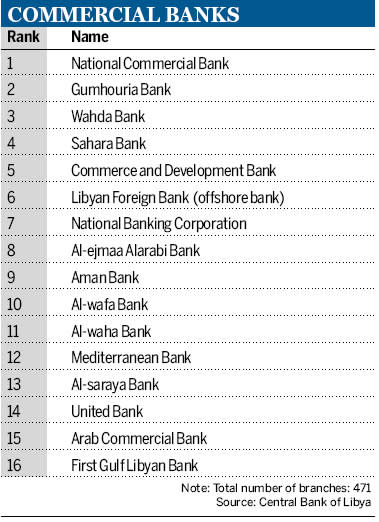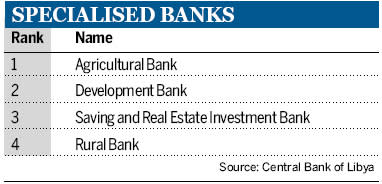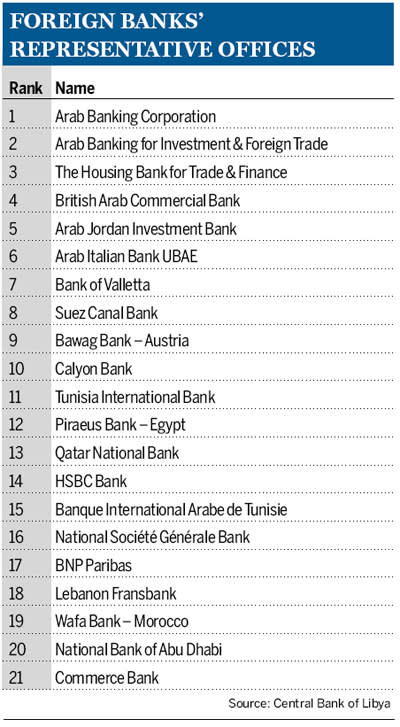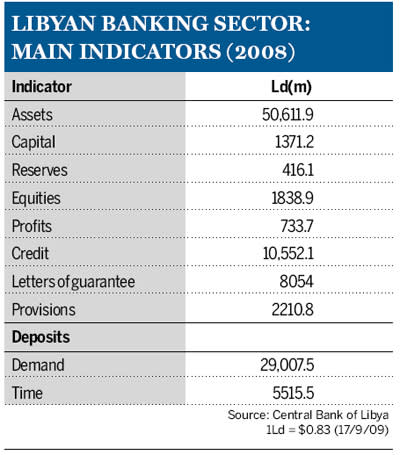Since emerging from international isolation earlier this decade, Libya's process of transformation has been underpinned by a programme of institutional reform that has had, as its core, the development and restructuring of the banking sector. The government's decision about five years ago that it no longer wanted to own the economy, but to be a prudent regulator, set in motion a series of reforms that are not only transforming the Central Bank of Libya (CBL) and its operations, but are also completely restructuring the entire banking system.
The past two years have witnessed a radical reappraisal of Libya's banking infrastructure, with privatisations, mergers, initial public offerings (IPOs) and the opening of foreign banks. From a collection of centralised state-owned bureaucracies, Libya is moving towards a more modern, commercially driven banking system that will bring the country into the 21st century and stimulate growth in both its oil and non-oil sectors. There is still a lot of work to be done, but as Driss Al-Habib, chief executive of Libya's first foreign bank, First Gulf Libyan Bank, says: "Libya is opening up slowly but surely and is heading in the right direction."
Shifting the balance
While Libya's banking is changing fast, the four big state-owned banks - Gumhouria Bank, Sahara Bank, Wahda Bank and National Commercial Bank (NCB) - still dominate the sector and account for about 90% of total bank assets of Ld50.6bn ($41.1bn), with Gumhouria accounting for 39%, followed by Sahara with 16%.
Libya has a total of 16 commercial banks, which have 471 branches, and four specialised banks in its system at present. Libyan Foreign Bank (LFB), known as Libyan Arab Foreign Bank until 2005, is included in the 16 commercial entities, but because it is considered an offshore bank, its considerable assets of $16.6bn at the end of 2008 are not included in the aggregate figure. While LFB played a critical role in Libya's financial relations with the rest of the world during the difficult era in which sanctions were imposed upon the country, it is not clear in this post-sanctions era what its new role will be.
Given that Sahara and Wahda are now part-privatised with foreign partners (BNP Paribas and Arab Bank, respectively, holding 19% stakes and management contracts) and that Gumhouria has completed a 15% IPO and NCB is soon to follow, the sector is ripe for change.
Farhat Bengdara, governor of the CBL, has made it clear that he wants to see the banking sector privatised in two years, and more mergers, takeovers and acquisitions by foreigners are predicted. Besides the big four banks there are nine small private banks among the current list of commercial banks. The biggest of these are Commerce and Development Bank, Aman Bank, Al-ejmaa Alarabi Bank and Al-wafa Bank. All of these small banks have had their minimum capital raised to Ld30m by the end of 2008 and opportunities for mergers are expected.
Although relatively small, Aman, established as the country's first private bank in 2003, has a reported network of 22 branches and more than 60 ATMs across Libya and is expanding aggressively. In June this year, CBL gave permission to private banks to have foreign strategic partners. Under the new rules, foreign banks can acquire up to 49% of any local bank.

Commercial Banks

Specialised Banks
Growing appeal
Interest in buying into the Libyan banking market is growing, especially following news that three new banking licences are to be awarded in 2010. The UK's HSBC, which is one of 21 foreign banks with a representative office in Tripoli, missed out on its bid for Sahara Bank (which was won by BNP Paribas), but is very much intending to establish a presence. "We are keen to get one of the three new licences expected to be issued next year," says Ray Webber, chief executive of HSBC in Tripoli. Bankers acknowledge that Libya is evolving slowly but also note that the country has been helped by the global recession in that the economy and the banking sector are virtually unaffected and there is a great deal of money available. With lots of projects under way, especially in infrastructure, foreign banks are anxious to get a slice of the action in this growing market.
In addition to the commercial banks, Libya has four specialised banks, led by the country's Development Bank and Agricultural Bank, which had total assets at the end of 2007 of Ld1.9bn and Ld1.7bn, respectively. These four banks are owned by the General People's Committee for Finance and although still important, appear to be taking a back seat when compared to the expansion of the commercial banks.
The International Monetary Fund (IMF) in its latest Article IV consultation in June warns: "The on-lending of government funds by specialised credit institutions [SCIs] has been both hampering commercial banks' ability to conduct financial intermediation and contributing to excess liquidity." The SCIs' share of total credit, according to the IMF, was more than 45% in 2007, a relatively high level, but this declined in 2008 as the CBL continues to push the role of commercial banks and the private sector.
There are also 42 small regional banks which have been combined to form the National Banking Corporation (NBC). The NBC is still government-owned and acts as a commercial bank, but it has formed a separate company to spin off the bad loans from these regional banks. The consolidation of the regional banks is another example of the tightening up of Libya's financial system.
Period of diversification
Recent reports from overseas say that the availability of financing on the local market is weak, Libyan banks offer limited financial products and public bank managers lack clear incentives to expand their portfolios. However, evidence over the past year or so suggests that the traditional approaches to banking are changing, especially with foreign banks entering the market and new products being introduced.
Modernisation is working and customers are gaining confidence in banks. This can be seen clearly in the growth of bank credit and deposit figures. In 2005, total bank credits actually fell to Ld6.2bn, but in 2006 they grew by 14.6%, followed by 15.9% growth in 2007 to reach Ld8.2bn. But in 2008 lending expanded dramatically by 28.7% to reach Ld10.5bn. So the lack of financing in the past, which acted as a brake on Libya's development, is changing and the strong growth experienced in 2008 is expected to continue this year and into the future.
Deposits with commercial banks have also surged. Combined demand and time deposits, which were Ld9.9bn and Ld3.7bn, respectively, in 2005, jumped by a significant 27.3% in 2006, by 40.1% in 2007 and maintained this growth in 2008 with combined deposits expanding 38% to reach Ld34.5bn. Demand deposits, at Ld29bn at the end of 2008, were almost triple those of 2005, suggesting growing confidence in the banks and a booming economy.
Structural adjustments
While the CBL steers its course away from being owner and regulator to that of just prudent regulator with the help of the international financial institutions, other important structural changes are taking place. The CBL is intent on strengthening banking supervision and regulations in line with best international practices, strengthening the role of its standing committees, such as the monetary and investment committees, and establishing others such as the financial stability committee. It is also aspiring to have the highest standards of corporate governance and professional excellence.
Following new regulations on risk concentrations in 2008, the CBL plans, according to its director of banking supervision and exchange control, Dr Mohamed Abusneina, to issue new regulations on Islamic banking before October this year. He says that the CBL also intends to issue new specific regulations on corporate governance at the same time. The Islamic banking regulations are keenly awaited as many bankers believe there is a huge unmet demand for these products and they will provide another important source of growth in both retail and wholesale areas.
The credit bureau, known as the Libyan Credit Information Center (LCIC), went live in April this year. The system began with the four big banks and aims to cover most of the banks by the end of the year. The LCIC will initially focus on the commercial side, just corporates and small and medium-sized enterprises, with individual consumers to be included in due course.

Foreign Banks' Representative Offices
Improving connectivity
Marking another financial milestone, the CBL is putting together the many complex aspects of a national payments system. Last year the CBL went live with a real-time gross settlement system based on the RTS/X solution from Swedish supplier CMA Small Systems. A number of other projects concerning an automated clearing house, ATMs, automated cheques process and core banking are under way at present. Mr Abusneina believes that with the new iFlex core banking system implemented at the CBL and new systems at the banks, all branches should be linked by the end of 2009, making for a big improvement in branch connectivity.
As a number of these projects are completed this year and access to Visa becomes available, the quality of ATM, card services and overall payments are expected to improve markedly. In another related development, point-of-sale technology is expected to begin a testing period in the next few months, bringing added sophistication to the retail arena.
Meanwhile, the CBL's own restructuring is moving ahead apace. The IMF's recent report said: "The introduction in May 2008 of CBL's certificate of deposit [CD] was an important step in modernising the monetary policy framework. The IMF supports the CBL's plan to expand the range of maturities for the CDs (especially by adding shorter maturities) and to develop an auction mechanism for them."
Positive prospects
In analysing the actual position of the banks, they still have a long way to go to become efficient, commercial entities in terms of performance, staffing and products, but many core fundamentals are in place and the upside potential appears huge. Credit rating agency Standard & Poor's, in its July rating, said: "Non-performing loans amount to 25% of the total, down from a peak of 36% in 2004; capital adequacy stands at 15%. Liquidity is extremely high: the system-wide loan-to-deposit ratio stood at about 30% in mid-2008. Banks have limited exposure to the global financial crisis: almost no external debt and still low, albeit growing, external assets."
According to S&P, financial intermediation in Libya is low, with credit to the private sector and non-financial public enterprises amounting to just 12% of gross domestic product in 2008. S&P added that lending has been held back by state dominance of the economy, state ownership of the banks, a weak commercial legal system and crowding out by the specialised credit institutions. This has certainly been the case. But in the past two to three years, the comprehensive reform programme of the financial sector is taking concrete, measured steps to address these issues and recent evidence indicates that the transformation of Libya's archaic banking infrastructure is well under way.

Libyan Banking Sector: Main Indicators (2008)











